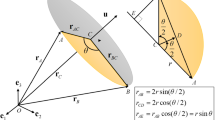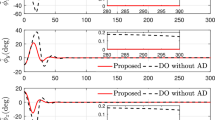Abstract
Through the direct parameter approach, a solution for spacecraft attitude tracking is presented. First of all, the spacecraft attitude tracking control model is built up by the error equation of the second-order nonlinear quaternion-based attitude system. Based on the control model, a suitable controller is designed by the direct parameter approach. Compared with other control strategies, the direct parameter approach can offer all degrees of freedom for the controller to satisfy the requirements for system properties and turn the original nonlinear system into closed-loop linear system. Furthermore, this paper optimizes the controller according to the robustness, limitation of controller output and closed-loop eigenvalue sensitivity. Putting the controller into the original system, the state response of the closed-loop system and the output of controller are plotted in Matlab to verify the availability and robustness of the controller. Therefore, the controlled spacecraft can achieve the goal of tracking on the mobile target with the external disturbance torque.
Similar content being viewed by others
References
G. R. Duan. Quaternion-based satellite attitude control-A direct parametric approach. In Proceedings of the 14th International Conference on Control, Automation and Systems, IEEE, Seoul, Korea, pp. 935–941, 2014.
G. R. Duan. Satellite attitude control-A direct parametric approach. In Proceedings of the 11th World Congress on Intelligent Control and Automation, IEEE, Shenyang, China, pp. 3989–3996, 2014.
C. Y. Gao, Q. Zhao, G. R. Duan. Robust actuator fault diagnosis scheme for satellite attitude control systems. Journal of the Franklin Institute, vol. 350, no. 9, pp. 2560–2580, 2013.
A. G. Parlos, J. W. Sunkel. Adaptive attitude control and momentum management for large-angle spacecraft maneuvers. Journal of Guidance, Control and Dynamics, vol. 15, no. 4, pp. 1018–1028, 1992.
H. Bang, C. K. Ha, J. Hyoung Kim. Flexible spacecraft attitude maneuver by application of sliding mode control. Acta Astronautica, vol. 57, no. 11, pp. 841–850, 2005.
S. N. Singh, R. Zhang. Adaptive output feedback control of spacecraft with flexible appendages by modeling error compensation. Acta Astronautica, vol. 54, no. 4, pp. 229–243, 2004.
A. Tayebi. Unit quaternion-based output feedback for the attitude tracking problem. IEEE Transactions on Automatic Control, vol. 53, no. 6, pp. 1516–1520, 2008.
D. Bustan, S. K. H. Sani, N. Pariz. Adaptive faulttolerant spacecraft attitude control design with transient response control. IEEE/ASME Transactions on Mechatronics, vol. 19, no. 4, pp. 1404–1411, 2014.
R. Kristiansen, P. J. Nicklasson. Satellite attitude control by quaternion-based backstepping. In Proceedings of American Control Conference, IEEE, Portland, USA, vol. 2, pp. 907–912, 2005.
D. Doody. Spacecraft attitude control. Deep Space Craft, D. Doody, Ed., Berlin Heidelberg, Germany: Springer, pp. 87–118, 2009.
A. Grewal, V. J. Modi. Robust attitude and vibration control of the space station. Acta Astronautica, vol. 38, no. 3, pp. 139–160, 1996.
K. F. Lu, Y. Q. Xia. Adaptive attitude tracking control for rigid spacecraft with finite-time convergence. Automatica, vol. 49, no. 12, pp. 3591–3599, 2013.
A. L. Herman, B. A. Conway. Optimal spacecraft attitude control using collocation and nonlinear programming. Journal of Guidance, Control and Dynamics, vol. 15, no. 5, pp. 1287–1289, 1992.
B. Wie, K. W. Byun, V. W. Warren, D. Geller, D. Long, J. Sunkel. New approach to attitude/momentum control for the Space Station. Journal of Guidance, Control and Dynamics, vol. 12, no. 5, pp. 714–722, 1989.
J. D. Schierman, D. G. Ward, J. R. Hull, N. Gandhi, M. Oppenheimer, D. B. Doman. Integrated adaptive guidance and control for re-entry vehicles with flight test results. Journal of Guidance, Control and Dynamics, vol. 27, no. 6, pp. 975–988, 2004.
H. J. Shen, P. Tsiotras. Optimal two-impulse rendezvous using multiple-revolution lambert solutions. Journal of Guidance, Control and Dynamics, vol. 26, no. 1, pp. 50–61, 2003.
F. Zhang, G. R. Duan. Optimal integrated relative position and attitude control of spacecraft in proximity operation missions. International Journal of Automation and Computing, vol. 9, no. 4, pp. 342–351, 2012.
H. Du, G. L. Fan, J. Q. Yi. Nonlinear longitudinal attitude control of an unmanned seaplane with wave filtering. International Journal of Automation and Computing, vol. 13, no. 6, pp. 634–642, 2016.
W. K. Liu. Research on Attitude Maneuver and Tracking for Flexible Spacecraft, Master dissertation, Harbin Institute of Technology, China, 2014. (in Chinese)
L. Zhang, G. R. Duan, Y. A. Zhang. Nonlinear dynamic model and control of three-axis stabilized liquid-filled spacecraft attitude system. Journal of Harbin Institute of Technology (New Series), vol. 19, no. 5, pp. 107–112, 2012.
G. R. Duan. Direct parametric control of fully-actuated second-order nonlinear systems-The normal case. In Proceedings of the 33rd Chinese Control Conference, IEEE, Nanjing, China, pp. 2406–2413, 2014.
G. R. Duan, B. Zhou. Solution to the second-order Sylvester matrix equation MVF2 + DVF + KV = BW. IEEE Transactions on Automatic Control, vol. 51, no. 5, pp. 805–809, 2006.
G. R. Duan. Generalized Sylvester Equations: Unified Parametric Solutions, New York, USA: CRC Press, pp. 15–393, 2015.
G. R. Duan. Parametric eigenstructure assignment in second-order descriptor linear systems. IEEE Transactions on Automatic Control, vol. 49, no. 10, pp. 1789–1794, 2004.
Acknowledgement
The first author hereby extends her thanks to all the classmates in the Center for Control Theory and Guidance Technology in Harbin Institute of Technology, because of their help in the academic research and daily life. Additionally, the first author thanks professor Bin Zhou for his help of academic paper writing.
Author information
Authors and Affiliations
Corresponding author
Additional information
This work was supported by National Natural Science Foundation of China (No. 61321062).
Recommended by Associate Editor Chandrasekhar Kambhampati
Xiao-Yi Wang received the B. Sc. degree from Department of Control Science and Engineering, Harbin Institute of Technology, China in 2014. She received the M. Sc. degree in Centre for Control Theory and Guidance Technology, Harbin Institute of technology, China in 2017.
Her research interests include nonlinear robust control and spacecraft attitude control.
Guan-Ren Duan received the B. Sc. degree in applied mathematics from Yanshan University, China in 1983, the M. Sc. degree in control systems theory from Harbin Engineering University, China in 1986, and received the Ph.D. degree in control systems theory from Harbin Institute of Technology, China in 1989. From 1989 to 1991, he was a post-doctoral researcher at Harbin Institute of Technology, where he became a professor of control systems theory in 1991. He visited the University of Hull, UK, and the University of Sheffield, UK from December 1996 to October 1998, and worked at the Queens University of Belfast, UK from October 1998 to October 2002. Since August 2000, he has been elected specially employed professor at Harbin Institute of Technology sponsored by the Cheung Kong Scholars Program of the Chinese government. He is currently the director of the Centre for Control Systems and Guidance Technology at Harbin Institute of Technology. He is the author and co-author of over 300 publications. He is a chartered engineer in the UK, a senior member of IEEE and a fellow of IEE.
His research interests include robust control, eigenstructure assignment, descriptor systems, missile autopilot control and magnetic bearing control.
Rights and permissions
About this article
Cite this article
Wang, XY., Duan, GR. A direct parametric approach to spacecraft attitude tracking control. Int. J. Autom. Comput. 14, 626–636 (2017). https://doi.org/10.1007/s11633-017-1089-4
Received:
Accepted:
Published:
Issue Date:
DOI: https://doi.org/10.1007/s11633-017-1089-4




